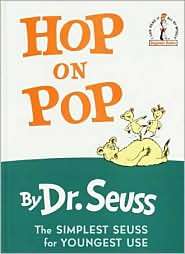Hop on Pop
Hop on Pop (ISBN 978-0-394-80029-5) is a 1963 children's picture book by Dr. Seuss (Theodor Seuss Geisel). It was published as part of the Random House Beginner Books series, and is subtitled "The Simplest Seuss for Youngest Use". It contains several short poems about a variety of characters, and is designed to introduce basic phonics concepts to children.
 | |
| Author | Dr. Seuss |
|---|---|
| Illustrator | Dr. Seuss |
| Country | United States |
| Language | English |
| Genre | Children's Literature |
| Publisher | Random House, The Living Books Company (1998) |
Publication date | 1963 (Renewed in 1991) |
| ISBN | 978-0-394-80029-5 |
| Preceded by | Dr. Seuss's ABC |
| Followed by | Fox in Socks |
History
One of Geisel's manuscript drafts for the book contained the lines, "When I read I am smart / I always cut whole words apart. / Con Stan Tin O Ple, Tim Buk Too / Con Tra Cep Tive, Kan Ga Roo."[1] Geisel had included the contraceptive reference to ensure that publisher Bennett Cerf was reading the manuscript. Cerf did notice the line,[2] and the poem was changed to the following: "My father / can read / big words, too. / Like... / Constantinople / and / Timbuktu."[1]
Reception
A popular choice of elementary school teachers and children's librarians, Hop on Pop ranked sixteenth on Publishers Weekly's 2001 list of the all-time best-selling hardcover books for children.[3] Based on a 2007 online poll, the National Education Association named the book one of its "Teachers' Top 100 Books for Children."[4]
One of the book's most notable advocates is former United States First Lady Laura Bush, who listed it as her favorite book in a 2006 Wall Street Journal article. "It features Dr. Seuss's typically wonderful illustrations and rhymes, of course, but the main thing for me is the family memory—the loving memory—that the book evokes of George lying on the floor and reading it to our daughters, Barbara and Jenna. They were little bitty things, and they took Hop on Pop literally, and jumped on him—we have the pictures to prove it," she wrote.[5]
In 2013, an official complaint was made to the Toronto Public Library that the book "encourages children to use violence against their fathers." The library decided against removing the book, finding it "is a humorous and well-loved children’s book designed to engage children while teaching them reading skills."[6]
Inspiration for others
Like many Dr. Seuss books, Hop on Pop has inspired other writers. Big Brother Mouse, a publishing project in Laos, drew on Hop on Pop to develop The Polar Bear Visits Laos, which matches short sentences that include an internal rhyme with cartoon images.
See also
External links
References
- Thomas Fensch. The Man Who Was Seuss. New Century Books, 2001. 149.
- Judith and Neil Morgan. Dr. Seuss and Mr. Geisel. Random House. 1995. 178-9.
- Phillip Nel. Dr. Seuss: American Icon. Continuum International Publishing Group, 2005. 3-4.
- National Education Association (2007). "Teachers' Top 100 Books for Children". Retrieved August 19, 2012.
- Laura Bush. "Pursuits: Books; Five Best". Wall Street Journal. September 30, 2006. 8.
- Lauren O'Neil, "Toronto library asked to ban 'violent' Dr. Seuss book Hop on Pop," CBC News, April 30, 2014, URL accessed May 1, 2014.